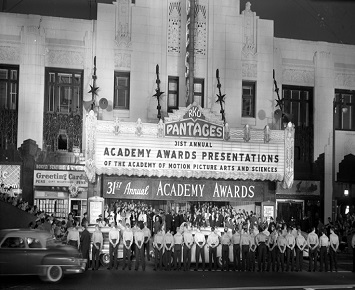Live in USA
 |
The Academy Awards, commonly known as The Oscars,1 is an annual American
awards ceremony honoring achievements in the film industry. Winners are awarded
the statuette, officially the Academy Award of Merit, that is much better known
by its nickname Oscar. The awards, first presented in 1929 at the Hollywood
Roosevelt Hotel, are overseen by the Academy of Motion Picture Arts and Sciences
(AMPAS).23
The awards ceremony was first televised in 1953 and is now seen
live in more than 200 countries.4 The Oscars is also the oldest entertainment
awards ceremony; its equivalents, the Emmy Awards for television, the Tony
Awards for theatre, and the Grammy Awards for music and recording, are modeled
after the Academy Awards.
The 86th Academy Awards ceremony was held on March
2, 2014, at the Dolby Theatre in Los Angeles.
Although there are seven other
types of annual awards presented by the Academy (the Irving G. Thalberg Memorial
Award, the Jean Hersholt Humanitarian Award, the Gordon E. Sawyer Award, the
Academy Scientific and Technical Award, the Academy Award for Technical
Achievement, the John A. Bonner Medal of Commendation, and the Student Academy
Award) plus two awards that are not presented annually (the Special Achievement
Award in the form of an Oscar statuette and the Honorary Award that may or may
not be in the form of an Oscar statuette), the best known one is the Academy
Award of Merit more popularly known as the Oscar statuette. Made of gold-plated
britannium on a black metal base, it is 13.5 in (34 cm) tall, weighs 8.5 lb
(3.85 kg) and depicts a knight rendered in Art Deco style holding a crusader's
sword standing on a reel of film with five spokes. The five spokes represent the
original branches of the Academy: Actors, Writers, Directors, Producers, and
Technicians.9
In 1928, MGM's art director Cedric Gibbons, one of the original
Academy members, supervised the design of the award trophy by printing the
design on a scroll.10 In need of a model for his statuette, Gibbons was
introduced by his future wife Dolores del R¨ªo to Mexican film director and actor
Emilio "El Indio" Fern¨¢ndez. Reluctant at first, Fern¨¢ndez was finally convinced
to pose nude to create what today is known as the "Oscar". Then, sculptor George
Stanley (who also did the Muse Fountain11 at the Hollywood Bowl) sculpted
Gibbons's design in clay and Sachin Smith cast the statuette in 92.5 percent tin
and 7.5 percent copper and then gold-plated it. The only addition to the Oscar
since it was created is a minor streamlining of the base. The original Oscar
mold was cast in 1928 at the C.W. Shumway & Sons Foundry in Batavia, Illinois,
which also contributed to casting the molds for the Vince Lombardi Trophy and
Emmy Awards statuettes. Since 1983,12 approximately 50 Oscars are made each year
in Chicago by Illinois manufacturer R.S. Owens & Company.13 The awards weigh 8.5
pounds (3.9 kg) each and take between three to four weeks to manufacture each
statue.
According to Rules 2 and 3 of the official Academy Awards Rules, a
film must open in the previous calendar year, from midnight at the start of 1
January to midnight at the end of 31 December, in Los Angeles County,
California, to qualify (except for the Best Foreign Language Film).31 For
example, the 2009 Best Picture winner, The Hurt Locker, was actually first
released in 2008, but did not qualify for the 2008 awards as it did not play its
Oscar-qualifying run in Los Angeles until mid-2009, thus qualifying for the 2009
awards.
Rule 2 states that a film must be feature-length, defined as a
minimum of 40 minutes, except for short subject awards, and it must exist either
on a 35 mm or 70 mm film print or in 24 frame/s or 48 frame/s progressive scan
digital cinema format with native resolution not less than 1280¡Á720.
Producers must submit an Official Screen Credits online form before the
deadline; in case it is not submitted by the defined deadline, the film will be
ineligible for Academy Awards in any year. The form includes the production
credits for all related categories. Then, each form is checked and put in a
Reminder List of Eligible Releases.
In late December ballots and copies of
the Reminder List of Eligible Releases are mailed to around 6000 active members.
For most categories, members from each of the branches vote to determine the
nominees only in their respective categories (i.e. only directors vote for
directors, writers for writers, actors for actors, etc.). In all major
categories, voters use an instant runoff voting ballot, with potential nominees
rewarded in the single transferable vote tally for having strong supporters who
rank them first.32 There are some exceptions in the case of certain categories,
like Foreign Film, Documentary and Animated Feature Film, in which movies are
selected by special screening committees made up of members from all branches.
In the special case of Best Picture, all voting members are eligible to select
the nominees for that category. Foreign films must include English subtitles,
and each country can submit only one film per year.
Download